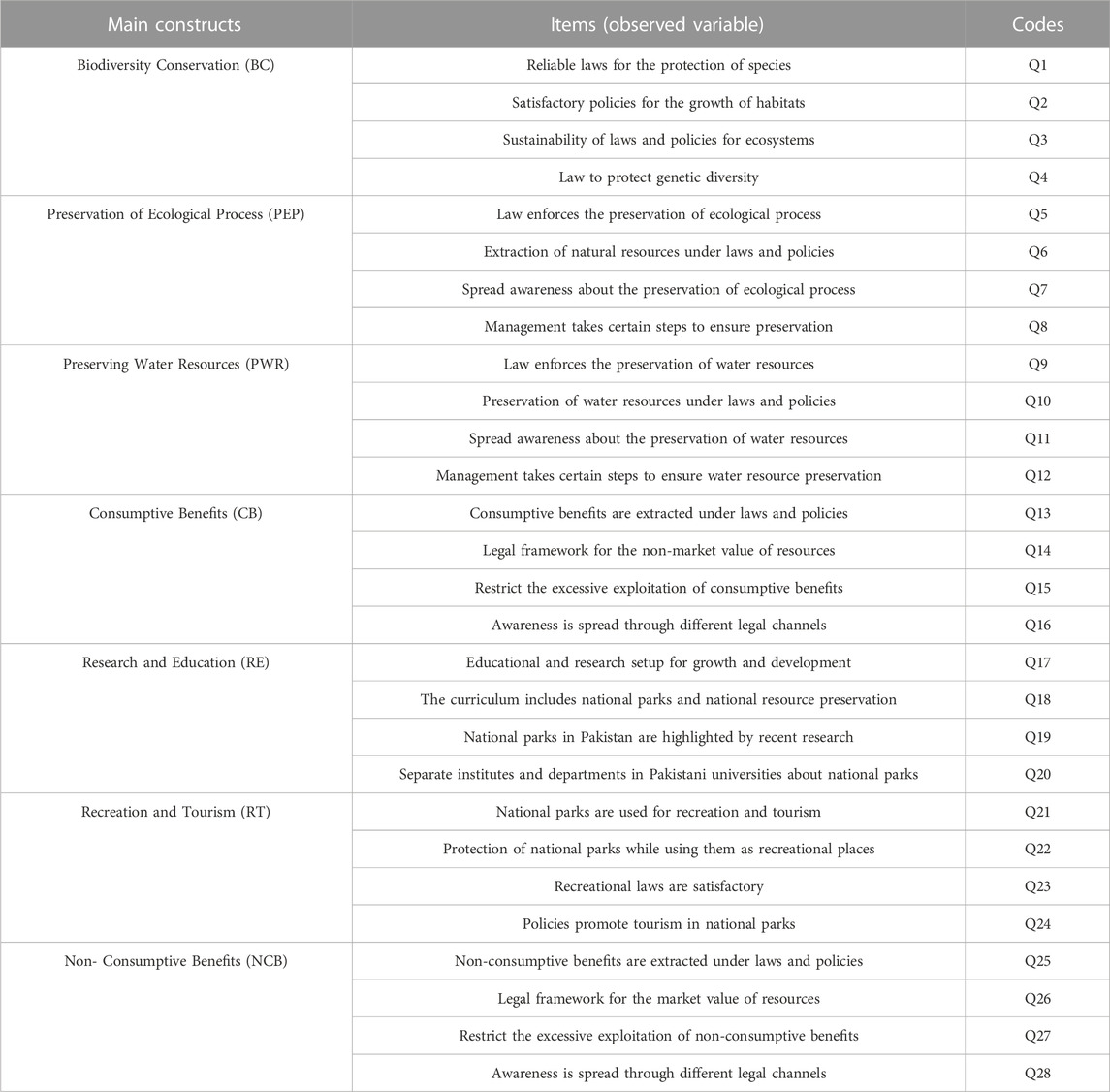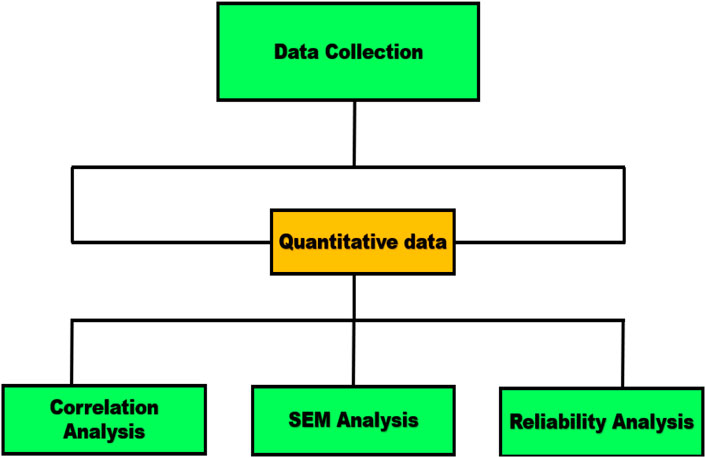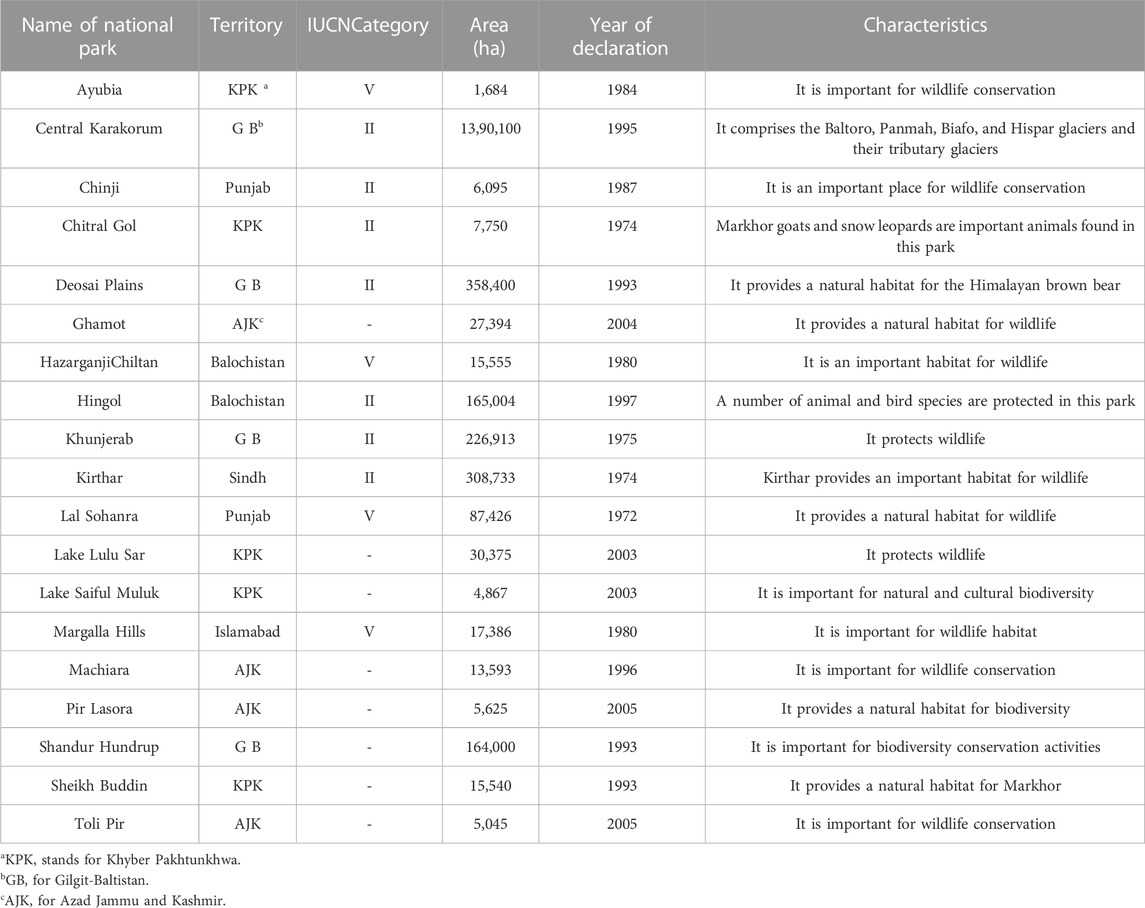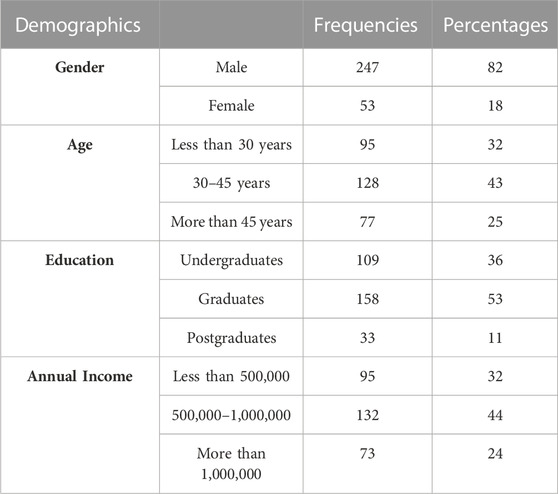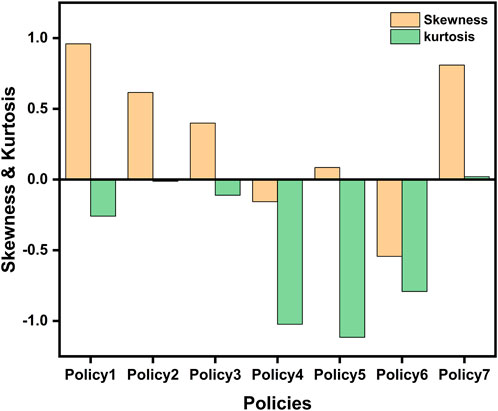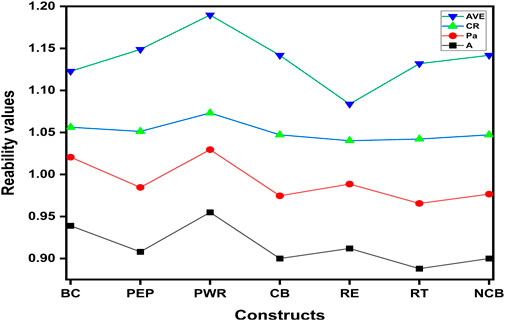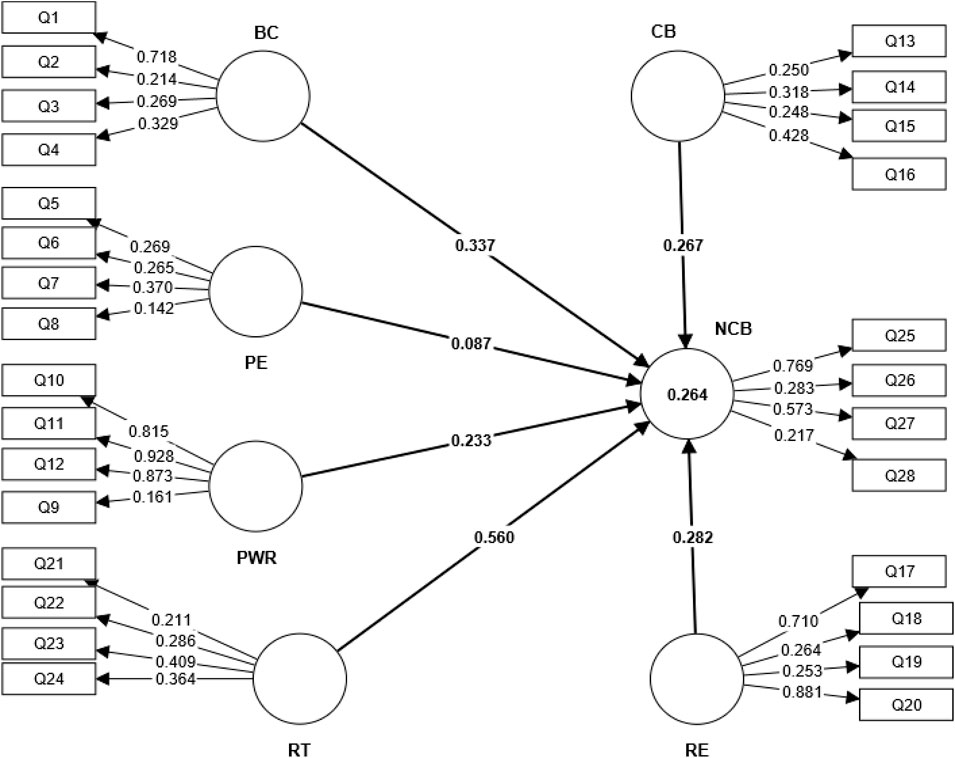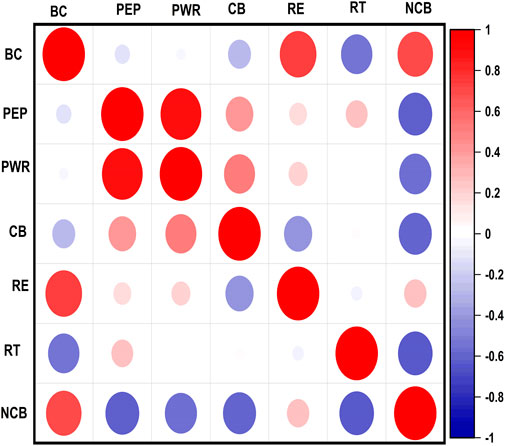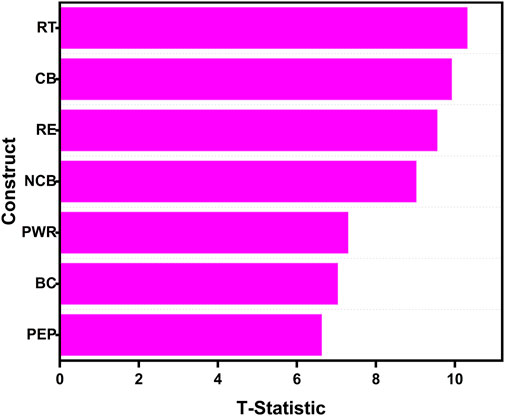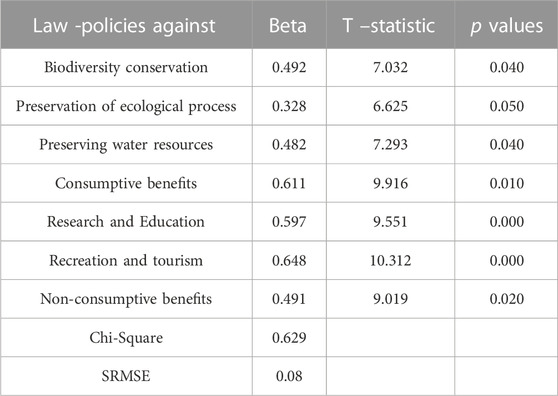- 1School of Public Administration, China University of Geosciences, Wuhan, China
- 2University of Chinese Academy of Sciences, Beijing, China
- 3State Key Laboratory of Cryospheric Sciences, Northwest Institute of Eco-Environment and Resources, Chinese Academy of Sciences, Lanzhou, China
- 4China-Pakistan Joint Research Center on Earth Sciences, CAS-HEC, Islamabad, Pakistan
- 5Hubei University of Automotive Technology, Shiyan, China
Ecological history is crucial in ecosystem restoration, serving as a tool to identify and characterize suitable restoration targets. Pakistan has implemented laws and policies to enhance forest sustainability and preserve biodiversity, as it is becoming a global strategy for future water planning and management. This study seeks to analyze the impact of national park policies and laws on various factors, including biodiversity conservation, ecological processes preservation, water resource protection, consumptive and non-consumptive benefits, research and education, and the promotion of recreation and tourism. To assess the effectiveness of established policies in 19 National Parks in Pakistan, a mixed-mode research design was utilized, combining both quantitative and qualitative approaches. Data was collected from 300 participants through a close-ended questionnaire employing a Likert scale. Analysis of the collected data was conducted using the software Smart Partial Least Squares method. The findings demonstrate that the existing policies and laws have contributed to the preservation of forest sustainability in Pakistan. The policies related to recreation and tourism; consumptive benefits; and research are more effective respectively compared to other sets of regulations. The laws and policies related to preservation of ecological processes are least effective. The study suggests that laws related to national parks need to be revised to preserve biodiversity and ecological processes. The preservation of water resources should be a major concern, and the consumptive benefits of these parks should be rechecked. Awareness campaigns are to be part of the expansionary policy framework, and while tourism opportunities should be created, a check on natural resource misuse should be implemented. The non-consumptive benefits of these parks should also be assessed. Due to its potential limitations, such as limited stakeholder analysis, difficulty in creating legitimacy in national parks due to bureaucratic structures, lack of community sensitization, and long-term trends in sustainable conservation strategies, there are certain future research directions that can address challenges in studying the impact of policies on national park habitats. There is a pressing demand for a more dynamic approach to ecological policymaking. Continuous evaluation and adaptation of policies will be essential in creating an environment conducive to sustainable development.
1 Introduction
Forest sustainability has received much attention globally not only due to ecological wellbeing but also as the source of income generation from tourism activities; this motivates several countries to protect the forest and establish related policies. As per the International Union for Conservation of Nature (IUCN, 2022), there are more than 4,000 national parks globally, and more than 270 million people visit the national parks of the United States. To increase the benefit from natural resources, sustainable forestry is intensively needed country-specific via establishing effective policies, including planting artificial forests, which is in a good stage of implementation; for instance, there are more than 200 parks and protected areas around the world (Aarts and Leeuwis, 2010 and effective measures for wellbeing therein (Adams et al., 2004). Australia has 45 different protected areas, including national parks and lands designed for further purposes for generating income (Adams and Hutton, 2007). Not only does this country reserve an area for natural resources, but there has also been a significant increase in global security assets (Agrawal and Gibson, 1999). Currently, the estimates show that more than 12% of the land is protected for forest purposes and other activities for income generation. However, it was reduced compared to the 1950s, when at least 15% of the world’s land area was reserved (Butt et al., 2023). Despite being critical to human wellbeing, the future supply of many Family Economic Support Services (FESs) is threatened by many factors, including habitat loss and destruction, pollution and nutrient excess, climate change, and others (Arts and Tatenhove, 2004). Biodiversity loss is directly linked to the loss of many FESs (Bajgier-Kowalska and Rettinger, 2014). Forests are subject to market forces that prioritize the provision of specific services over the organization and culture of external free zones. However, forest owners are unable to generate income from the broad ecosystem services, forcing them to make management decisions based on marketable inputs, such as wood production (Ahmad et al., 2022; Císař, 2022). In turn, forest management practices have been identified to significantly affect the different levels of FESs provided by forests and their habitat’s suitability and species (Kovacic and Benini, 2022). Conservation function and regional biodiversity were noted as indicators of synergistic relationships between specific FES arrangements (Beunen and de Vries, 2011). The ecosystem services have entered the political arena (Bezák and Halada, 2010). On the other hand, competing demands on forests are also increasing as multipurpose, such as hunting, the industrial economy’s demand for vital raw materials, non-market cultural and organizational FESs, such as recreation, biodiversity, water conservation, and social needs (Carmin, 2010; Gani et al., 2023). Therefore, the management plan relied on effective policy implications from the scientific studies that can enhance the sustainable forest for ecosystem and environmental issues across global and country-specific. Recent studies revealed that laws and policies make sure that national parks support extensive conservation, act as an anchor for large ecosystems, and are catalysts for ways to conserve wildlife habitat and resources (Armitage et al., 2010) and for the park to grow the air, water, and wildlife must be safe to enter and exit the park (Quick and Bryson, 2022).
Currently, each country has different laws, policies, and regulations for forest management. Like the rest of the world, Pakistan the sixth largest population in the world is one developing countries (Butt et al., 2023b) also has laws and policies for national parks, including recreation and tourism, biodiversity conservation, non-consumptive benefits, preservation of ecological processes, preserving water resources, research and education, and consumptive benefits. The Wildlife Conservation Act inherited from British India includes provisions amended by the West Pakistan Wildlife Conservation Act of 1959 and the West Pakistan Wildlife Conservation Act of 1960. In addition, neither the West Pakistan Forest Protection Act nor the Pakistan Forest Act applies to five fixed regions of Pakistan (such as the Kabul and Indus floodplains and all eastern countries), nor does it apply to part of the country, mountainous areas of the country and special/royal areas where many valuable species are found in Pakistan (Butt et al., 2023c). The Wildlife Research Council was established in 1968 to review regulations (Williams and Baláž, 2002), but the scientific research regarding eco-system services is still at a low stage (Sotirov et al., 2017). Currently, the management of national parks in Pakistan falls under the jurisdiction of the Pakistan Environmental Protection Agency (Pak-EPA) and the respective provincial environmental protection agencies. The most relevant policy instruments include the Pakistan Environmental Protection Act, of 1997, and the provincial environmental protection acts. These laws outlined the framework for environmental protection and conservation efforts, including the establishment and management of national parks. Additionally, specific policies and regulations related to wildlife conservation and protected areas are also operating. (Afzal et al., 2023; Banerjee et al., 2023).
The orientations towards ecological development research are also facing several challenges due to a lack of available resources, access to information, and awareness. Population growth, rapid urbanization, unregulated industrialization, increased auto-mobilization, regulated/unregulated land use, and land cover transformations are the cardinal challenges for urban social life in Pakistan. The enforcement and implementation of environmental laws and policies are challenging due to resource constraints, such as limited financial and human resources, which hinder the agency’s ability to monitor and enforce compliance, potentially impeding its mandate (Kumar et al., 2023). The lack of specialized skills in environmental science, ecology, and law poses challenges in recruitment and retention. Regular legal reviews are crucial to address emerging environmental issues. Robust policies are needed for climate change mitigation and adaptation, while industrial compliance and effective waste management are additional environmental protection complexities (Shah and Rana, 2023). The anthropogenic interventions in the natural environment and the rapid proliferation of consumer culture are further stressing the environmental and social resilience of urban areas (Wells, 1992; Pathak et al., 2023). Therefore, the sustainability of urban ecological resources is a valid point for the equity and justice debate. This makes it incumbent upon community research to investigate the dynamics, orientations, and factors responsible for current urban environmental degradation in Pakistan. The outcomes of such research initiatives are a prerequisite for ensuring the resilience and environmental health of urban areas in this country. Currently, Pakistan is facing several environmental issues which may impede ecological development, such as population growth, deforestation, and others. Current statistics show that the population growth rate is about 2.7%, and this growth is associated with high demand for food, more housing, more jobs, and the production of more waste, and linked with a weak environment, with the right regulations, newer and better technology (Young et al., 2007). Pakistan, in its efforts to enhance forest sustainability and conserve biodiversity, has implemented several policies and laws (Wilson, 1999). However, the effectiveness of these measures remains to be thoroughly explored, and only a few studies have been conducted on this issue, and there is a gap in the existing literature (Banerjee et al., 2020). Therefore, this study addresses the existing gap in the literature by conducting an in-depth mixed-mode analysis to delve into the phenomena and acquire comprehensive insights. The primary objective of this study is to analyze the effectiveness of national park policies and laws on various sustainability factors in Pakistan. These factors include biodiversity conservation, preservation of ecological processes, protection of water resources, consumptive benefits, research and education, recreation, and tourism, as well as non-consumptive benefits. To the best of our knowledge, these is no such study found on the subject related to national parks in Pakistan that engages all the stakeholders and provides a basic analysis that how the laws should be tailored, taught and executed in their naturally blessed areas.
The findings will offer valuable guidance to policymakers and environmental organizations in formulating effective strategies for preserving the country’s precious natural resources.
The present study hypothesized that.
H1. There is a positive relationship between laws and policies and the biodiversity conservation of national parks in Pakistan.
H2. There is a positive relationship between laws and policies and the preservation of the ecological process of national parks of Pakistan.
H3. There is a positive relationship between laws and policies and preserving the water resources of the national parks of Pakistan.
H4. There is a positive relationship between laws and policies and the consumptive benefits of the national parks of Pakistan.
H5. There is a positive relationship between laws and policies and research and education of national parks of Pakistan.
H6. There is a positive relationship between laws and policies and the recreation and tourism of the national parks of Pakistan.
H7. There is a positive relationship between laws and policies and the non-consumptive benefits of national parks in Pakistan.
2 Datasets and methodology
2.1 Research design and data collection
A mixed-mode research design integrating quantitative and qualitative approaches is employed to comprehensively evaluate the effectiveness of established policies for 19 National Parks in Pakistan out of a total of 28 such locations. To include at least one Park from each region (because some regions have very few parks), 19 are selected on the basis of geographically distinct, biodiversity and habitat. The study’s population consists of environmental organizations based in Pakistan. A strategic sampling approach which is the application of focused data collection across targeted areas of the conceptual site model, is used to select 300 participants, including forest beneficiaries and policymakers, who are well-informed about the protection status of the National Parks. Brown (2006) provides significant details about strategic sampling approach. Data are collected through a close-ended questionnaire designed to capture responses related to the forest sustainability policies and their effectiveness. The questionnaire was administered to the selected participants, allowing for a thorough assessment of the policies’ impact on National Park protection. The main constructs observed in this study pertain to the established policies’ impact on various aspects of National Park protection, including biodiversity conservation, preservation of ecological processes, water resource preservation, consumptive and non-consumptive benefits, research and education, and recreation and tourism. Details of these constructs are outlined in (Table 1).
2.2 Data analysis
To achieve the main objective of the study, confirmatory factor analysis (CFA) was performed using Smart-PLS 4 software (see Ringle et al., 2022). CFA enables the evaluation of the relationship between observed variables (forest sustainability policies) and the underlying latent variable (established laws and policies for National Park Protection) by estimating direct and indirect factor loadings. In CFA, researchers distinguish between observed variables (directly measured) and latent variables (unobserved constructs). Latent variables are abstract ideas that researchers attempt to indirectly assess using observable indicators.
Structural Equation Modelling (SEM) was applied, incorporating CFA and path analysis, to explore the interconnectedness of variables and assess the overall model fit (Ramayah et al., 2018). CFA helps determine the reliability of construct measures and understand the nature of these variables. Additionally, Pearson correlation analysis was conducted to identify any linear relationships among observations, elucidating the importance of each factor influencing forest policy. The conceptual framework of the study is visually presented in Figure 1 and Table 2.
3 Results
3.1 Distributive statistics of participants
Table 3 presents the descriptive statistics of the participants involved in capturing the effectiveness of laws and policies in strengthening the protection of national parks and resources in Pakistan, as outlined by the seven identified laws and policies. Out of the 300 respondents, approximately 82% were male, while the remaining participants were female. The majority of respondents, 43%, fell within the age group of 30–45 years, while 32% were less than 30 years old, and 25% were above 45 years old. These demographics indicated a diverse representation of age groups, allowing for a comprehensive perspective on the effectiveness of the policies.
Regarding educational qualifications, 53% of participants were graduates, 36% were undergraduates, and 11% were postgraduates. This distribution ensured a well-informed and varied respondent pool capable of providing relevant insights for achieving the study’s objectives.
Analyzing annual income, 32% of respondents had an annual income of less than 500,000, while 44% had an annual income between 500,000 and 1,000,000, and 24% had more than 1,000,000. This income distribution ensured a balanced representation of participants from different economic backgrounds, contributing to a holistic understanding of policy effectiveness.
To validate the normal distribution of the primary data, a normality test was conducted (Figure 2). The results from kurtosis and skewness indicated that the data were approximately normally distributed. The large sample size further supported the normality of the data. The Cramer-von Mises test statistic has the null hypothesis that a sample, comes from a pre-specified population distribution indicates that the highest statistic is 6.861 for policy 1, and lowest for policy 5. It indicates α greater than0.95 in all cases (Table 4).
3.2 Reliability and validity of testing outcomes
To assess the effectiveness of policies on forest sustainability, Smart Partial Least Squares (Smart-PLS version 4.0) was employed. Reliability testing of the selected features to respond to the effectiveness of laws and policies for protecting biodiversity and ecological processes in national parks of Pakistan, based on several strategic views from respondents, was conducted; the results are presented in Figure 3 and Table 5. The Cronbach’s alpha values obtained indicate the reliability of the policies’ effectiveness in protecting national parks in Pakistan.
Based on the reliability statistics, the scores from Cronbach’s Alpha are quite close to 1, suggesting that the information gathered from respondents is highly reliable in reflecting the effectiveness of laws and policies in protecting national parks. These findings are consistent with previous research, which also recommended the acceptance level of Cronbach’s alpha coefficient as an indicator of reliability (see, for example, Saris and Gallhofer, 2014; Dillman, et al., 2016; DeVellis and Thorpe, 2021).
Furthermore, the outer loading and particular cross-loading, analyzed for construct reliability, exceeded the threshold limit of 0.7. This indicates that the item measurements taken from the sample accurately represent the actual scores in the population, confirming the reliability of the related information.
3.3 Finding of confirmatory factor analysis
Confirmatory factor analysis was conducted using Smart PLS-4 to assess the validity of the scale, specifically the strategic features concerning the laws and policies of national parks. The results revealed that some of the factor items, representing strategic questions aimed at capturing the effectiveness of laws and policies, did not elicit strong responses regarding the protection of biodiversity and other ecological processes in national parks.
As per the criteria for model building, items with factor loadings and average variance less than 0.5, as well as composite reliability less than 0.6, were deemed unsuitable and were subsequently deleted from the analysis. The remaining items, with factor loadings and average variance greater than 0.6, were retained in the model, as shown in Figure 4.
The decision to exclude certain items from the analysis was essential in ensuring the accuracy and reliability of the results. By focusing on the retained items with strong factor loadings and sufficient composite reliability, the study’s validity was enhanced, and a more accurate representation of the effectiveness of laws and policies in protecting national parks was achieved.
Figure 4 provides a clear visualization of the remaining items, demonstrating their significance in evaluating the impact of laws and policies on biodiversity conservation and ecological processes within national parks. These findings serve as a valuable guide for policymakers and stakeholders, highlighting the specific areas that need further attention and improvement to bolster the protection and sustainability of Pakistan’s national parks. Thereby, aiding in the formulation of targeted strategies and initiatives for the effective conservation and management of these ecologically vital areas.
3.4 Regression analysis for testing hypothesis
Table 6 presents the results of the hypothesis testing conducted on the laws and policies of national parks in Pakistan. The results indicate a positive relationship between laws and policies and various aspects of national park protection, including biodiversity conservation, preservation of ecological processes, preservation of water resources, consumptive benefits, and research and education.
These findings are statistically significant at the 5% significance level, with p-values less than 0.05 (i.e., p < 0.05). This suggests that the laws and policies implemented for protecting national parks in Pakistan have proven to be effective in promoting biodiversity conservation, preserving ecological processes, and safeguarding water resources, providing consumptive benefits, and supporting research and education initiatives.
However, the significant positive relationships between laws and policies and these key aspects of national park protection highlight the importance of effective policy implementation in achieving sustainable conservation goals. Policymakers and stakeholders can draw valuable insights from these results to further strengthen and refine existing laws and policies for the continued preservation and sustainability of Pakistan’s national parks.
3.5 Correlation and covariances between policies
Figure 5 and Table 7 display the results obtained from correlation and covariances tests between the policies themselves. The correlation analysis indicates that all selected policies, treated as latent variables in the model, demonstrate moderate correlations, both negative and positive, with each other. Notably, a strong positive correlation was observed between CB (Consumptive Benefits) and PEP (Preservation of Ecological Processes), as well as between RE (Research and Education) and PEP. These findings suggest that the strategies for protecting national parks, specifically in terms of research and education, recreation and tourism, and law implementation, are closely interconnected and aligned in Pakistan.
The variability observed in policies has a particularly noteworthy impact on research and education, in addition to recreation and tourism policies, which are also significantly affected. Conversely, when it comes to other policies, the variations are relatively minimal, with both negative and positive associations being evident. Overall, the findings from examining correlations and covariance provide compelling evidence that policy execution and implementation operate independently, yet contribute significantly to the protection and promotion of national parks and ecological resources within the country.
3.6 Evaluation of the inner structural model
After validating the data and measurement model, the next step in the analysis was to assess the results of the inner structural model. This involved measuring the predictive relevance of the model and examining the relationships between variables using various criteria, including coefficient of determination (R-square), path coefficient (β), effect size (ƒ2), and goodness of fit (GOF).
Figure 6 and Table 8 present the results of the path coefficients for all selected policies, showing that they are statistically significant at the 5% level. Additionally, the model fit is considered good, as evidenced by the acceptance of the standardized root mean square error (SRMSE), which is less than 0.08. The chi-square statistic and coefficient of determination, which is closer to one (0.629), further support the satisfactory model fit. These results indicate that the empirical data in this study fit well with the proposed model. Table 8 further explains that the policies related to Recreation and tourism; Consumptive benefits; and Research are more effective respectively compared to other sets of regulations included in the model. The laws and policies related to preservation of ecological processes are least effective.
Table 9 demonstrates the validity of discrimination, with all the Heterotrait-Monotrait (HTMT) values in this study being less than the benchmark of 0.85. This signifies that there are no issues with discriminant validity, indicating that the constructs are distinct from each other and accurately measure different aspects of the phenomenon under investigation.
Table 10 displays the goodness-of-fit of the inner model, determining whether the model adequately describes the empirical data of the study. The goodness-of-fit index scores range from 0 to 1, with readings of 0.10 (small), 0.25 (medium), and 0.36 (large) indicating the overall acceptance of the path model. The goodness-of-fit estimate of 0.561 suggests that the model fit is strong and reliable. The results from the inner structural model analysis affirm the soundness of the measurement and indicate that the proposed model effectively explains the relationships between the variables. The satisfactory model fit, along with strong discriminant validity and goodness-of-fit, further strengthens the credibility and validity of the study’s findings.
4 Discussion
Contemporarily research orientation has progressively shifted by comprising ecological development and government laws together with policies to protect national parks. A National Park is a protected area that is primarily managed for ecosystem protection and recreation. It is described as a natural area of land or water that has been designated to (a) protect the ecological integrity of one or more ecosystems for current and future generations, (b) prohibit exploitation or occupation, and (c) provide a foundation for spiritual, scientific, educational, recreational, and visitor opportunities, all of which must be open to the public. The present study aimed to analyze the effectiveness of policies and laws on the sustainability of national parks through various factors, including biodiversity conservation, preservation of ecological processes, preserving water resources, consumptive benefits, research and education, recreation and tourism, and non-consumptive benefits in Pakistan. The results revealed that forest sustainability is preserved under various laws and policies (Qasim et al., 2014). However, the study has further found that there are certain limitations and gaps in the laws and policies of national parks in Pakistan. There is a need for a periodic system to re-examine and reform ecological policies and laws to provide the requisite atmosphere for the performance-oriented and change-conscious public sector organizations we have all been craving in this country. The Pakistani government is constantly working to improve the country’s overall environmental sit situation. International organizations have accelerated biodiversity conservation efforts, but most of Pakistan’s national parks lack management plans to help improve the preservation of biodiversity of these parks. As a result, conservation efforts fall short of world standards. Additionally, a lack of laws and policies results in a depletion of wildlife in national parks. There have been initiatives in recent years to address these shortcomings. The framework for management provided by current wildlife laws is insufficient. The provincial wildlife departments are given authority by the laws to manage protected areas, but these departments are not given any authority to manage neighboring areas. As a result, development activities close to protected areas frequently interfere with efforts to preserve biodiversity. The enforcement of laws pertaining to biodiversity conservation has a number of flaws. The law has a serious flaw when it comes to species conservation because it focuses too much on animal species and makes no provisions for the protection of threatened and endangered plant species. The laws in place make an effort to restrict the hunting of animals that have been designated as game. However, the majority of these regulatory measures have proven challenging to uphold. A few rules have been established under the current laws to protect a few specific species (falcons, cranes); however, other important threatened species require the introduction of additional control measures. As a result, the ongoing loss of biodiversity and the fragmentation and degradation of natural habitats are the ecological trends that Pakistanis are currently most concerned about.
Throughout Pakistan, a number of projects related to the management and development of Protected Areas have been launched for conservation purposes. However, these projects are not very successful because of a number of internal problems that create barriers to the desired results. There is a lack of sufficient data in many respects. The current ability to gather, store, analyze, and disseminate information is limited, and data about Pakistan’s biodiversity are dispersed among a wide range of institutions. Additionally, knowledge of this aspect of biodiversity is sadly lacking. In order to maintain, store, organize, analyze, and disseminate data in a useful form, there is no biodiversity information and monitoring center. Furthermore, the creation of management plans and policies for these areas is fraught with flaws. For effective management to take place, local communities must use the protected area and be involved. None of the protected area classifications allow for community involvement. Local communities have a responsibility to protect and utilize the resources of biological diversity because they are its primary users. Local communities playing the roles of protectors and beneficiaries may be crucial to halting the loss of biodiversity in Pakistan. The rigidly prescribed framework of Pakistan’s national parks prevents locals from planning and carrying out. The legislation governing national parks forbids a number of uses. Additionally, it is critical to put policies and practices into place that promote resource conservation and responsible use. All parties must participate equally in the decision-making and execution processes in order for co-management to take place. The government must grant local communities and user groups equal management power and responsibility. Under this strategy, utilization, and control might coexist. Authorities must delegate decision-making to all user groups, including local communities, while also defending and enhancing local communities’ aspirations, knowledge, skills, and resources for practice (Rashid et al., 2020).
Due to inadequate enforcement, public indifference, and population growth, Pakistan’s biodiversity loss problem persists despite numerous regulations. To address these issues, Pakistan must strengthen its legal and regulatory frameworks, enhance law enforcement, and increase public awareness of biodiversity protection (Sotirov et al., 2017). The detrimental effects of tourism on the environment can be reduced through careful planning and management of tourism within protected areas. A framework was put forth by (Usmani, 2001) that prioritized three things: safeguarding the natural resource on which tourism is based, expanding and diversifying the tourism industry to have a positive economic impact, and dispersing the gains to nearby communities near PAs. However, as disturbances from recreational activities were the second most frequently reported threat to terrestrial pAs worldwide, increasing trends in tourism within protected areas could have negative ecological and social impacts, which would be made worse by ineffective protected area management. Managers of protected areas must communicate with other sectors more frequently. To accomplish this, in-service training programs for resource managers, conservationists, and other concerned employees are crucial, as are initiatives to boost nongovernmental organizations’ and community institutions’ capacity to contribute significantly to biodiversity conservation by providing funding, personnel, and resources to existing training programs (Knudsen, 1999). Protected areas and biosphere reserves require more scientific investigation, monitoring, training, and instruction because conservation and wise use of natural resources depend on a solid foundation in the natural, social, and humanities. This is essential for nations with protected areas that lack the funding and skilled human resources.
5 Conclusion
Pakistan faces numerous environmental issues such as deforestation, fragmentation, degradation, and biodiversity loss, hindering ecological development. Despite government efforts and international organizations’ involvement in biodiversity conservation, most national parks lack management plans, resulting in conservation efforts not meeting global expectations. In this regard, the regulations and policy reforms play a significant role in protecting the preserved national parks. This study examined the impact of various policies and laws on the sustainability of national parks in Pakistan, including the conservation of biodiversity, the preservation of ecological processes, the preservation of water resources. This study also describes the potential benefits of these efforts to consumers, researchers, and tourism (Lapov, 2018). The study found a strong link between legal frameworks, regulatory measures, and governmental policies in Pakistani national parks, enhancing the maintenance and preservation of living organisms and their habitats. These regulations and policies have a positive impact on the preservation of ecological processes, contributing to ecological balance and stability. They also preserve water resources like rivers, lakes, and groundwater reservoirs, ensuring their availability for future generations. Enforcement of these laws has resulted in sustainable resource utilization, responsible tourism, and employment opportunities for local communities. Legal frameworks and policies not only protect biodiversity and ecological processes but also foster an environment conducive to scientific research and educational activities, promoting knowledge and understanding of the natural world and its interconnections. Overall, these measures contribute to the overall stability and sustainability of Pakistani national parks. The study reveals that laws and policies used for Pakistan’s national parks face restrictions and gaps, necessitating the need for a periodic system to review and reform ecological policies and laws to foster performance-oriented public sector. Current wildlife laws do not provide a sufficient framework for management. The current legal system is seriously flawed when it comes to protecting threatened and endangered plant species because it places an excessive amount of emphasis on animal species. Communities are not permitted to participate in any of the protected area classifications. Because they are its main consumers, local communities must safeguard and make use of biological diversity’s resources. For co-management to occur, each stakeholder must have an equal voice in the decision-making and execution processes. Thus, there is a need for a periodic system to re-examine and reform ecological policies and laws to provide the requisite atmosphere for performance-oriented and change-conscious public sector organizations (Qadir, 2000). Some of the recommendations that should be taken into consideration for formulating a pertinent policy for effective conservation and sustainable utilization of natural resources.
The results of this study imply that there is a need to revise policies and laws of national parks to preserve the biodiversity conservation of the national parks of Pakistan. The preservation of the ecological process of the national parks of Pakistan is dependent on the policies and laws, so special consideration should be paid in this regard. Preserving water resources of the national parks of Pakistan should be one of the major concerns of the national laws and policies of Pakistan. The consumptive benefits of national parks of Pakistan should be rechecked while formulating the laws and national policies. Awareness campaigns for the people living in and visiting these areas should be part of an expansionary policy framework. Although tourism opportunities should be created, however, a check on the misuse of natural resources should be implemented. The non-consumptive benefits of the national parks of Pakistan should be assessed.
The study has certain limitations, which should be focused on in future studies. A future study should be carried out with detailed stakeholder analysis involving overwhelming communities. Creation of legitimacy in national parks is difficult and often fragile due to external and internal pressures. The bureaucratic structure in park management limits community participation, while poverty conditions and lack of community sensitization also hinder active participation. Long-term trends in evaluation of sustainable conservation strategies are the key challenge and pose another limitation to study the impact of policies on the habitat of national parks. These challenges arise from the vulnerability of these mechanisms to external and internal pressures.
Data availability statement
The raw data supporting the conclusion of this article will be made available by the authors, without undue reservation.
Ethics statement
Ethical review and approval was not required for the study on human participants in accordance with the local legislation and institutional requirements. Written informed consent from the [patients/ participants OR patients/participants legal guardian/next of kin] was not required to participate in this study in accordance with the national legislation and the institutional requirements.
Author contributions
BJ: Data curation, Formal Analysis, Methodology, Software, Visualization, Writing–original draft, Writing–review and editing. DH: Conceptualization, Funding acquisition, Resources, Supervision, Project administration, Writing–review and editing. DS: Data curation, Resources, Validation, Writing–review and editing. MA: Data curation, Methodology, Writing–original draft, Writing–review and editing. WS: Data curation, Validation, Writing–review and editing. ABa: Data curation, Methodology, Software, Writing–review and editing. QY: Data curation, Software, Writing–review and editing. ABu: Data curation, Software, Writing–review and editing.
Funding
The author(s) declare financial support was received for the research, authorship, and/or publication of this article. This work was financially supported by an international partnership of Chinese Academy of Sciences (Grant No. 046GJHZ2023069MI and 131C11KYSB20200022) and Gansu Provincial Science and Technology Program (Grant No. 22ZD6FA005) and Natural Science Foundation of China (42171148).
Acknowledgments
The authors would like to thank the Environmental Science Department, Pakistan and concerned people for supporting data collection. Moreover, the authors would like to acknowledge the referees for providing constructive suggestions which have helped to improve the scientific quality of this paper. Additionally, other authors have greatly acknowledged the Northwest Institute of Eco-environment and Resources, Chinese Academy of Sciences, Lanzhou, China for providing space and institutional facilities to conduct the partial part of this research.
Conflict of interest
The authors declare that the research was conducted in the absence of any commercial or financial relationships that could be construed as a potential conflict of interest.
Publisher’s note
All claims expressed in this article are solely those of the authors and do not necessarily represent those of their affiliated organizations, or those of the publisher, the editors and the reviewers. Any product that may be evaluated in this article, or claim that may be made by its manufacturer, is not guaranteed or endorsed by the publisher.
References
Aarts, N., and Leeuwis, C. (2010). Participation and power: reflections on the role of government in land use planning and rural development. J. Agric. Educ. Ext. 16 (2), 131–145. doi:10.1080/13892241003651381
Adams, W. M., Aveling, R., Brockington, D., Dickson, B., Elliott, J., Hutton, J., et al. (2004). Biodiversity conservation and the eradication of poverty. science 306 (5699), 1146–1149. doi:10.1126/science.1097920
Adams, W. M., and Hutton, J. (2007). People, parks and poverty: political ecology and biodiversity conservation. Conservation Soc. 5 (2), 147–183.
Afzal, M., Liu, T., Butt, A. Q., Nadeem, A. A., Ali, S., and Pan, X. (2023). Geospatial assessment of managed aquifer recharge potential sites in Punjab, Pakistan. Remote Sens. 15 (16), 3988. doi:10.3390/rs15163988
Agrawal, A., and Gibson, C. C. (1999). Enchantment and disenchantment: the role of community in natural resource conservation. World Dev. 27 (4), 629–649. doi:10.1016/s0305-750x(98)00161-2
Ahmad, K., Banerjee, A., Rashid, W., Xia, Z., Karim, S., and Asif, M. (2022). Assessment of long-term rainfall variability and trends using observed and satellite data in central Punjab, Pakistan. Atmosphere 14 (1), 60. doi:10.3390/atmos14010060
Armitage, D., Berkes, F., and Doubleday, N. (2010). Adaptive co-management: collaboration, learning, and multi-level governance. Vancouver, Canada: UBC Press.
Arts, B., and Tatenhove, J. V. (2004). Policy and power: a conceptual framework between the ‘old’and ‘new’policy idioms. Policy Sci. 37, 339–356. doi:10.1007/s11077-005-0156-9
Bajgier-Kowalska, M., and Rettinger, R. (2014). Considerations for tourism and recreation expansion in the vicinity of the czorsztyn-niedzica and sromowce wyżne water resevoir complex, located on the dunajec river. Geogr. Tour. 1 (2), 43–50.
Banerjee, A., Chen, R., Meadows, M., Singh, R. B., Mal, S., and Sengupta, D. (2020). An analysis of long-term rainfall trends and variability in the uttarakhand himalaya using google earth engine. Remote Sens. 12 (4), 709–711. doi:10.3390/rs12040709
Banerjee, A., Kang, S., Meadows, M. E., Xia, Z., Sengupta, D., and Kumar, V. (2023). Quantifying climate variability and regional anthropogenic influence on vegetation dynamics in northwest India. Environ. Res. 234, 116541. doi:10.1016/j.envres.2023.116541
Beunen, R., and de Vries, J. R. (2011). The governance of Natura 2000 sites: the importance of initial choices in the organisation of planning processes. J. Environ. Plan. Manag. 54 (8), 1041–1059. doi:10.1080/09640568.2010.549034
Bezák, P., and Halada, L. (2010). Sustainable management recommendations to reduce the loss of agricultural biodiversity in the mountain regions of NE Slovakia. Mt. Res. Dev. 30 (3), 192–204. doi:10.1659/mrd-journal-d-10-00023.1
Brown, A. (2006). “Strategic sampling,” in Monitoring nature conservation in cultural habitats: a practical guide and case studies (Dordrecht: Springer Netherlands), 43–54.
Butt, A. Q., Shangguan, D., Da, L., Khan, A. A., Tan, Y., Mukhtar, M. A., et al. (2023b). Gradual changes in snow peaks in upper Indus basin, Pakistan: a google earth based review. J. Mt. Area Res. 8, 110–122. doi:10.53874/jmar.v8i0.185
Butt, A. Q., Shangguan, D., Waseem, M., Haq, F. U., Ding, Y., Mukhtar, M. A., et al. (2023a). Ascertainment of hydropower potential sites using location search algorithm in hunza river basin, Pakistan. Water 15 (16), 2929. doi:10.3390/w15162929
Butt, F. K., Shangguan, D., Butt, A. Q., Arshad, M. T., Raja, B. N. K., Khitab, A., et al. (2023c). An experimental study to mitigate environmental impacts by transforming waste plastic bags into paving blocks and roof tiles. Sustainability 15 (22), 15801. doi:10.3390/su152215801
Carmin, J. (2010). NGO capacity and environmental governance in Central and Eastern Europe. Acta Polit. 45, 183–202. doi:10.1057/ap.2009.21
Císař, O. (2022). “Rhapsody in green: environmental movements in east central europe,” in The routledge handbook of environmental movements (London, UK: Routledge), 32–44.
DeVellis, R. F., and Thorpe, C. T. (2021). Scale development: theory and applications. Thousand Oaks, California: Sage publications.
Dillman, D. A., Smyth, J. D., and Christian, L. M. (2016). Internet, phone, mail and mixed-mode surveys: the tailored design method. Reis 154, 161–176.
Gani, A., Pathak, S., Hussain, A., Ahmed, S., Singh, R., Khevariya, A., et al. (2023). Water quality index assessment of river ganga at haridwar stretch using multivariate statistical technique. Mol. Biotechnol., 1–24. doi:10.1007/s12033-023-00864-2
IUCN (2022). International union for conservation of nature (IUCN). https://www.iucn.org (assessed March 16, 2023).
Knudsen, A. (1999). Conservation and controversy in the karakoram: khunjerab national park, Pakistan. J. political Ecol. 6 (1), 1–30. doi:10.2458/v6i1.21421
Kovacic, Z., and Benini, L. (2022). Striking the balance: sustainability and institutional transitions in the European environment agency. Futures 141, 102984. doi:10.1016/j.futures.2022.102984
Kumar, L., Naqvi, S. A., Deitch, M. J., Khalid, M. J., Naeem, K., Qayyum Amjad, A., et al. (2023). Opportunities and constraints for cleaner production policy in the developing world: a case study of Sindh Region. Pakistan: Environment, Development and Sustainability, 1–44.
Lapov, Z. (2018). Transition from a traditional nature and game reserve to a national park: the case of khunzhrav valley in northern Pakistan. NAVEIÑ REET NORDIC J. LAW Soc. Res. 8, 13–32.
Pathak, S., Sharma, S., Banerjee, A., and Kumar, S. (2023). A methodology to assess and evaluate sites with high potential for stormwater harvesting in Dehradun, India. Big Data Res. 35, 100415. doi:10.1016/j.bdr.2023.100415
Qadir, A. (2000). Exploration for natural gas in protected areas: the case of Kirthar National Park in Pakistan. Parks Int. J. Prot. Area Manag. 10 (1), 45–50.
Qasim, S., Khan, A. N., and Qasim, M. (2014). A comparative study of conservation strategies of two selected national parks from Pakistan and Thailand: lessons learned from each other. J. Manag. Sci. 8 (1).
Quick, K. S., and Bryson, J. M. (2022). “Public participation,” in Handbook on theories of governance (Cheltenham, UK: Edward Elgar Publishing), 158–168.
Ramayah, T. J. F. H., Cheah, J., Chuah, F., Ting, H., and Memon, M. A. (2018). Partial least squares structural equation modeling (PLS-SEM) using smart-PLS 3.0. An updated guide and practical guide to statistical analysis.
Rashid, W., Shi, J., Rahim, I. U., Dong, S., and Sultan, H. (2020). Issues and opportunities associated with trophy hunting and tourism in Khunjerab National Park, Northern Pakistan. Animals 10 (4), 597. doi:10.3390/ani10040597
Ringle, C. M., Wende, S., and Becker, J.-M. (2022). SmartPLS 4. Oststeinbek: SmartPLS. Available at: https://www.smartpls.com.
Saris, W. E., and Gallhofer, I. N. (2014). Design, evaluation, and analysis of questionnaires for survey research. Hoboken, New Jersey: John Wiley and Sons.
Shah, S. S., and Rana, I. A. (2023). Institutional challenges in reducing disaster risks in the remote city of Hindukush-Karakorum-Himalayan (HKH) region, Pakistan. Int. J. Disaster Risk Reduct. 88, 103581. doi:10.1016/j.ijdrr.2023.103581
Sotirov, M., Stelter, M., and Winkel, G. (2017). The emergence of the European Union Timber Regulation: how Baptists, Bootleggers, devil shifting and moral legitimacy drive change in the environmental governance of global timber trade. For. Policy Econ. 81, 69–81. doi:10.1016/j.forpol.2017.05.001
Usmani, S. (2001). Environmental offensive in Pakistan –Pakistani's NGO's struggle against pollution of the environment by multi-national oil corporation. Non-St. Actors Int'l L. 1, 215–218. doi:10.1163/15718070121003545
Wells, M. (1992). Biodiversity conservation, affluence and poverty: mismatched costs and benefits and efforts to remedy them. Ambio 21, 237–243.
Williams, A. M., and Baláž, V. r. (2002). The Czech and Slovak Republics: conceptual issues in the economic analysis of tourism in transition. Tour. Manag. 23 (1), 37–45. doi:10.1016/s0261-5177(01)00061-9
Wilson, E. (1999). Capacity for environmental action in Slovakia. J. Environ. Plan. Manag. 42 (4), 581–598. doi:10.1080/09640569911073
Keywords: ecology, laws and policy, national parks, Pakistan, legalization, mixed mode study
Citation: Javeed B, Huang D, Shangguan D, Ahsan Mukhtar M, Sajjad W, Banerjee A, Yang Q and Butt AQ (2024) Assessing the effectiveness of national park’s policies and laws in promoting biodiversity conservation and ecological development in Pakistan. Front. Environ. Sci. 11:1333650. doi: 10.3389/fenvs.2023.1333650
Received: 05 November 2023; Accepted: 13 December 2023;
Published: 23 January 2024.
Edited by:
Deepak Kumar, University at Albany, United StatesReviewed by:
Faraz Ui Haq, University of Memphis, United StatesMuhammad Mehran Bashir, Muhammad Nawaz Sharif University of Engineering and Technology, Pakistan
Copyright © 2024 Javeed, Huang, Shangguan, Ahsan Mukhtar, Sajjad, Banerjee, Yang and Butt. This is an open-access article distributed under the terms of the Creative Commons Attribution License (CC BY). The use, distribution or reproduction in other forums is permitted, provided the original author(s) and the copyright owner(s) are credited and that the original publication in this journal is cited, in accordance with accepted academic practice. No use, distribution or reproduction is permitted which does not comply with these terms.
*Correspondence: Donghui Shangguan, ZGFoZ3VhbkBsemIuYWMuY24=
 Banafsha Javeed
Banafsha Javeed Delin Huang1
Delin Huang1 Donghui Shangguan
Donghui Shangguan Muhammad Ahsan Mukhtar
Muhammad Ahsan Mukhtar Wasim Sajjad
Wasim Sajjad Asim Qayyum Butt
Asim Qayyum Butt